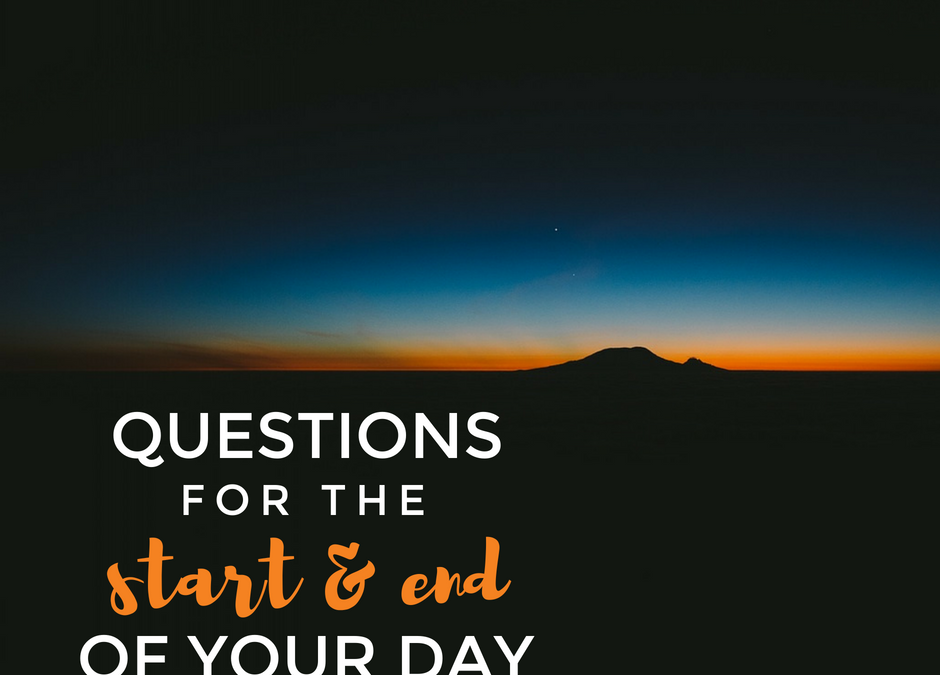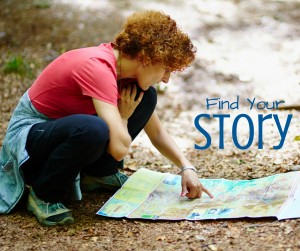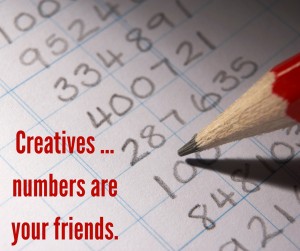
by Naomi | Apr 6, 2016 | Creative Life
When we don’t leave room in our plans, we squash the possibility of surprise. What’s worse, we often don’t realize we’re limiting ourselves.
Picture two actors onstage, beginning an improvised scene.
Actor One: (pointing frantically) Oh no, look, it’s a Tyrannosaurus Rex.
Actor Two: (leaning forward) And look, he’s nodding at us. I think he’s trying to tell us something.
Actor One: He’s running straight toward us! Run!
Actor Two: (running along behind Actor One, looking over her shoulder) I wonder if we should try to talk to him?
Actor One: He’s a monster. AGGGGH! Run!
Actor Two can’t salvage the scene, and ends up running offstage with Actor One. The scene is over.
In improv, we call this scenario “saying no.”
Actor One began the scene planning for a T-Rex to chase her offstage. No matter what her scene partner said, Actor One insisted the scene go as she planned. She said no to all the options and possible surprises Actor Two introduced.
Why might this happen?
Actor One might be feeling nervous. The audience is watching, and the silence is lengthening. So, she blurts out the first thing that comes to mind. There’s a T-Rex! Good! Drama. Danger. The silence is broken. But Actor Two, relieved of the burden of introducing the first idea, sees the dead-end problem in the scene. Two actors shrieking and running away isn’t really a scene. So, Actor Two introduces the possibility that this T-Rex isn’t like other dinosaurs. If Actor One allows this new idea to develop, something interesting might happen. Neither actor is responsible entirely for the success of the scene. Both actors are likely to be surprised. When actors are bold enough to say yes to the unknown, interesting things can happen.
Often, we say no in our real lives, too.
- We have a firm agenda for a meeting or class and refuse to be sidetracked, even when interesting opportunities for learning or exploration arise.
- We mentally script a conversation or confrontation and don’t leave room to listen and respond in real time.
- We schedule our days to their very edges and don’t leave room for serendipitous detours.
Unfortunately, the solution isn’t as easy as throwing plans out the window. Classes, confrontations, and even day-to-day schedules suffer if we don’t prepare at all. Maybe here, we can learn a thing or two from improvisational actors.
- First, improv actors know that improvisation is a skill to be practiced and refined. It’s not a “who cares, I don’t need a script” attitude. Rather, improv actors shift their focus from practicing for ONE predictable scenario into practicing for a MULTITUDE of scenarios. They practice listening, saying yes, and adding ideas to move the game forward.
- Second, improv actors know that every scene is an experiment. Some will work better than others, and some will completely fail. They accept the failures as part of the learning process.
- Third, improv actors build possibilities in the spaces between people, rather than limiting the options to their own experience, ideas and skill set. They aren’t afraid to collaborate and to allow others to help.
Recently, I’ve been challenged to take steps forward into new territory–artistically, professionally, and personally. What’s fascinating is how pertinent my improv training continues to be, no matter how far the challenge is from an actual stage. It turns out that improvisation can be a training ground for real life. As in on-stage improv, when you approach life’s situations with an open-for-surprise attitude, delightful things can happen.
I wonder: In what life situation might you practice the art of improvisation? I hope you try it, and if you do, share your story on Instagram or Twitter and tag me. I’d love to hear how the experiment goes for you.

by Naomi | Apr 1, 2016 | Creative Life
In The Art of Possibility, Rosamund Stone Zander and Benjamin Zander point out that this harmless little question might not be so harmless after all. Why? Well, the underlying question for most of us is, “What did I accomplish today?” And the danger is that we’re measuring the value of our day based on our answer.
If you’re a novelist and you spend the day working on a difficult passage, ending up with 500 words, it’s all too easy to judge the day a failure. Only 500 words today. Or, what if at the end of a day of teaching, you realize that you spent most your time resolving a heartfelt conflict in your classroom but hardly any time on spelling?
Asking the wrong question leads to the wrong answer. And the wrong answers, over time, lead to skewed thinking, poor decisions, and too often, a sense of discouragement and confusion.
And yet, reflection is an important part of growth. The momentum that growth brings is key to staying motivated and engaged.
So … What helpful reflection questions might we ask ourselves at the end of the day?
Here are a few I’m going to try.
- When did I feel grateful today?
- When did I feel connected today?
- When did I listen to someone today, and what did I hear?
- What did I learn today?
- What challenged me today?
- What made me curious today, and how might I explore my questions tomorrow?
Donald Miller used to have a course about life-planning. In it, he encouraged people to ask themselves in the morning: “If I could do today over, what would I do differently?” Projecting yourself to the end of the day and thinking about what honestly matters shifts the day’s focus from that addictive to-do list to something more lasting and important.
I’m enjoying the experiment–these book-end question sessions at the start and end of the day. Want to try it out too? I’d love to hear about your experience. Tag me on Instagram or Twitter and let’s chat about it. In the meantime, here’s to you and your creative journey.
by Naomi | Mar 31, 2016 | Creative Life
Patricia Newman is the author of numerous books, including Plastic, Ahoy! Investigating the Great Pacific Garbage Patch, and Ebola: Fears and Facts. She is a passionate literacy advocate and profiles authors and illustrators for California Kids, a regional parenting magazine. I was delighted to have the opportunity to chat with Patricia about creativity and writing for one of her thoughtful profiles. Here’s an excerpt from our interview.
—
INTERVIEW WITH NAOMI KINSMAN by PATRICIA NEWMAN
Naomi Kinsman weaves her life around the creative process. Not only plumbing the depths of creativity for her middle-grade novels, but in teaching children and adults to find their passion for their stories. She started the Society of Young Inklings about eight years ago—named for C.S. Lewis’ and J. R. R. Tolkien’s Inklings group—to help children find their voices as writers. Naomi and I are represented by the same literary agency, and our paths frequently cross in the writing world. Her devotion to her craft is both inspirational and instructive. I spoke to Naomi by telephone to find out more about her creative process.
Patricia: Is there a childhood memory that sticks out in your mind?
Naomi: I was a very, very shy child. When I was in second grade, my mom took me to see a production of Annie, and I saw this little girl up on stage and she was exuberant and boisterous and I wanted that opportunity to try on a different personality. Around the same time our school was doing a musical called “Totally Buggy.” There was this character, a ladybug, who had this beautiful jazzy solo. I had my heart set on being the ladybug, but I couldn’t bring myself to audition. I admitted to my friend that I wanted the part. She got me to sing while we were alone on the swings. “The wind will be so loud I won’t be able to hear you,” she said. We did that day after day, and we got louder and louder. One day in class the girl who was the ladybug was sick, and the teacher asked for volunteers. Somehow I raised my hand. Everyone looked at me. No one thought I would do it, but I sang. I remember hearing my own voice in my ears, having my class look at me, and saying to myself you can do the impossible thing.
Read more …
—
Psst… Do you know about Naomi’s Tinder Box: a weekly collection of curated resources, inspiration and encouragement? Keep your creative spark ablaze … sign up for exclusive access here.
by Naomi | Mar 24, 2016 | Creative Life

How do you consume stories? Do you read them? Listen to them? Watch them? Play them out? How many stories have you consumed today? This week?
I’ll venture to guess that stories are a staple of your every day diet, and not just because you’re the kind of person who reads this blog. There’s a reason brands use stories as the foundation for multi-million dollar commercials such as the ones aired during the Super Bowl.
Humans crave stories.
Donald Miller, as part of his Storybrand workshops, points out that stories are built on patterns. Those patterns create clarity in the human mind. In a well-crafted story, a character has a problem and sets out to solve it. Through the story’s twists and turns, the character strives for the desired solution, and in the end he or she either achieves success or does not.
But the point is: We KNOW what the character wants. We can see the character’s progress. We have a mental picture of what success looks like. All the twists and turns in the story are given meaning, when viewed in light of the goal.
Often, life doesn’t feel that clear.
First of all, it’s not easy to figure out the exact problem and identify a clear solution or goal. Maybe we want fourteen things all at the same time. Or maybe we know what we want but we doubt our motives. We want external guidance and assurance that we’re headed in the right direction.
Second, it’s not easy to gauge success. When we watch a character try to solve a problem, we can usually read into his or her internal reasons for needing that problem to be solved. Maybe externally, the Three Pigs each want to build their own houses. But what they really need is a safe place to live. When they end up together in the brick house, safe from the wolf, their deeper longing has been met. They are safe. In our real lives, when we don’t reach our external goals, we feel frustrated. Even if our internal problem is solved, we may not realize that is the case, leaving us feeling foggy and uncertain. We wonder: Have I made progress? Often the missed goal blinds us to the actual success.
But is the story pattern impossible to see in our own lives?
No. Not impossible. And when we do glimpse the story pattern, every twist and turn and challenge and success becomes that much more meaningful. The fog on the path ahead clears, and we see how to carry our life story forward.
Here are some questions I find helpful when reflecting on my own life story.
- What goals am I working toward? (I often look at six key areas of my life when asking this question: core, creativity, commitment, connection, cultivation, casting dreams. More on those categories here.)
- Why? (I ask the question about each goal, and list all the answers that come up.)
- And that’s important because …? (I look at the answers and push myself to go a little deeper. These second tier answers are usually closer to my real reasons.)
- Is there an overall goal that ties these goals together? (Stories make more sense when they are unified. An overall goal might be “I want to be healthy in body, relationships, mind, and spirit.”)
- Am I just starting out or have I been on this journey for a while? (You can decide whether to look at a small, recent story or one that you’ve been telling for a long time. The size of the story is up to you. The goal is to choose a story that is meaningful to you at this current stage of your life.)
Question five can be the basis to draw a map for your life story. Where are the notable successes and where are the setbacks? The more whimsical the map, the more it can transform your experience into something objective that you can look at from the outside. The map then becomes a living document that can accompany you on the journey.
I hope you’ll try this process out for yourself. Over the past couple years, I’ve used a map to chart the story of my year. I’ve gained so much perspective from seeing my story told in this visual, streamlined way. I hope the same is true for you! Feel free to share your story below, or share with the greater community on Facebook or Twitter.
—
Psst… Do you know about Naomi’s Tinder Box: a weekly collection of curated resources, inspiration and encouragement? Keep your creative spark ablaze … sign up for exclusive access here.
by Naomi | Mar 7, 2016 | Creative Life
 I’ve never been much of a numbers girl. When someone asks what nine times twelve is, I’m reminded of those pages filled with multiplication problems and the clock tick, tick, ticking away. Even now, the memory makes my heart take flying leaps against my rib-cage.
I’ve never been much of a numbers girl. When someone asks what nine times twelve is, I’m reminded of those pages filled with multiplication problems and the clock tick, tick, ticking away. Even now, the memory makes my heart take flying leaps against my rib-cage.
Because of my number dread, I don’t capture data in numbers very often. For the most part, I rely on intuition and my memory.
The thing is, memory can be tricky. Stories can be revised. Intuition, while wise, can also be skewed. What I’ve learned recently is that whether you’re a numbers person or not, numbers are invaluable when it comes to creative problem-solving. It turns out, numbers are our friends.
Yep, you read that right. Numbers are our friends.
As a creative person, I constantly have new ideas sprouting up here and there and everywhere. I’m easily tricked into thinking that I can add “just one more thing” to my already full day. Were I to look at the numbers, I’d see that a day has 24 hours. Some of those hours are required for sleeping, eating, exercising, laughing … There’s a finite number of “just one more things” that a day can hold. The number 24 provides a distinct, specific problem to solve. How will I spend my 24 hours today?
Improvisational actors know that in order to create a great scene, a set of givens is required. The givens lead to interesting questions, and interesting questions lead to unexpected solutions. If the scene must include an elephant, an umbrella and a pickle, the actors can then work on how to make those things happen. The how is what makes the scene hilariously clever.
When you ask yourself, “How might I … ” along with a specific problem to solve, you’re likely to come up with a list that includes a few unusual and delightful solutions. But when you ask yourself, “What should I do about … ” and ponder a vague problem you’re facing, you’ll probably feel frustrated, blocked and stumped.
Let’s try it ourselves:
Q: How much time is there in your week?
A: This one is the same for all of us … 168 hours.
Q: What are your firm commitments and how many hours do they take on average?
A: This one is variable, but includes sleep, exercise, meals, family, and other non-negotiables.
Q: How much time is left over?
A: Time – Firm Commitments = Left Over Time
Q: How might you creatively utilize your left over time?
Let your mind roam here. You’ve done the hard math part, and now you can use your creative gifts. Explore the preposterous, turn the problem on its head, transform the boundaries into opportunities. See what you can come up with. Here’s the excellent news. This strategy goes far beyond offering solutions for your current time crunch. Now, you have a roadmap for tackling all those pesky life questions which have been bugging you.
The process goes like this:
- Gather the numbers and specific givens.
- Allow the numbers to shape a clear understanding of the problem.
- Use that understanding to shape a “How might I … ” question.
- Tap into your creativity to brainstorm a list of possible answers …
- And THEN listen to your intuition to choose which solution to try first.
Give your solution some time to kick in, and then check your results against the numbers. Now, you have a process that allows you to experiment and refine rather than inventing the wheel over and over, having no idea whether you’re making progress at all.
Now, here’s the thing. If you’re anything like me, gathering the numbers will be a little bit painful. Your creativity will lurch and struggle against the hard, firm lines of reality. And yet, that lurching and struggling is actually energy building, energy that will throw itself eagerly into problem solving as soon as you set it free. I promise that the pain is worth the results.
Will you try it for yourself? I hope you do. And when you do, let me know how it goes. Post in the comments below, or share your story with me on Facebook or on Twitter. I can’t wait to hear about your successes!
—
Psst… Do you know about Naomi’s Tinder Box: a weekly collection of curated resources, inspiration and encouragement? Keep your creative spark ablaze … sign up for exclusive access here.




 I’ve never been much of a numbers girl. When someone asks what nine times twelve is, I’m reminded of those pages filled with multiplication problems and the clock tick, tick, ticking away. Even now, the memory makes my heart take flying leaps against my rib-cage.
I’ve never been much of a numbers girl. When someone asks what nine times twelve is, I’m reminded of those pages filled with multiplication problems and the clock tick, tick, ticking away. Even now, the memory makes my heart take flying leaps against my rib-cage.